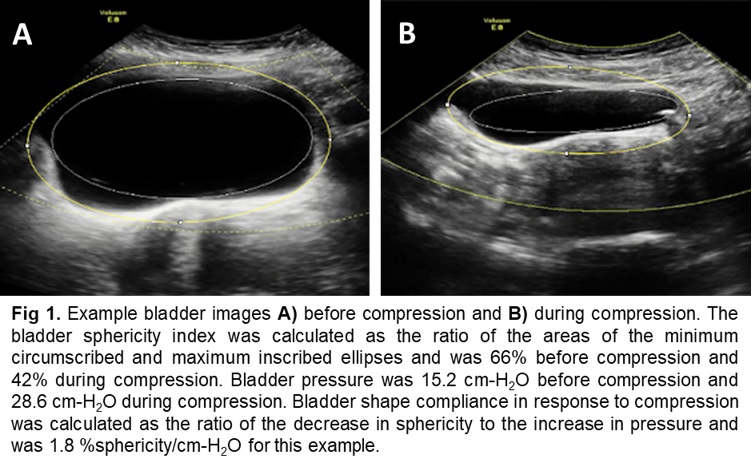Back
Poster, Podium & Video Sessions
Moderated Poster
MP33: Uroradiology I
MP33-10: Evaluation of Bladder Shape Compliance Using Abdominal Compressions During Urodynamics
Saturday, May 14, 2022
4:30 PM – 5:45 PM
Location: Room 228
Adam Vossenberg, Richmond, VA, Sarah Kodama, Richmond, WV, Ria Khandpur, Jared Dunlap, Abraham Alattar, William Visser, Christopher Bednarz*, Linda Burkett, Lauren Siff, Adam Klausner, John Speich, Richmond, VA
- CB
Christopher Paul Bednarz, MD
Virginia Commonwealth University Health System
Poster Presenter(s)
Introduction: Bladder shape may be important in overactive bladder. The objective of the present study was to use sphericity analysis to quantify bladder shape compliance in response to abdominal bladder compressions during urodynamics (UDS) and correlate this metric with participant characteristics.
Methods: Individuals indicated for UDS were enrolled in a prospective IRB-approved study. The bladder was filled to ~50% capacity during UDS and filling was paused for compression evaluation. Transverse abdominal ultrasound bladder images were captured, and the probe was used to compress the bladder five times to ~50% of its anterior-posterior diameter. Compressions lasted ten seconds each, with a ten second pause between compressions. One image before the first compression and one image at the maximum pressure of each compression were analyzed. A bladder sphericity index was defined as the ratio of the areas of the minimum circumscribed and maximum inscribed ellipses that were manually traced on the images using Image J (Fig 1). Shape compliance was calculated as the change sphericity index divided by the change in vesical pressure. Age and body mass index (BMI) data were collected.
Results: The study was completed by 22 women. The average sphericity index decreased from 64%±1% to 55%±1% (p < 0.05) due to compression and the pressure increased from 20±1 to 32±1 cm·H2O (p < 0.05). Bladder shape compliance ranged from 0.32 to 2.3 %sphericity/cm-H2O, with one outlier >28. Excluding the outlier, 8/9 (89%) women >57 years of age, but only 2/10 (20%) of women <57 years of age exhibited a bladder shape compliance value of <1.01 %sphericity/cm-H2O, indicating a significant association of age with shape compliance (Fisher’s exact, p<0.05) No association between BMI and bladder shape compliance was identified.
Conclusions: A novel technique was developed to quantify bladder shape compliance in response to compression, and decreased compliance was identified in older women. Future studies are needed to identify any relationship between bladder shape compliance due to compression and specific types of bladder dysfunction.
Source of Funding: NIH Grant R01DK101719, NSF REU Award 1852116, VCU Summer Fellowship for Undergraduate Research and Creative Scholarship, VCU Summer Research Fellowship Program

Methods: Individuals indicated for UDS were enrolled in a prospective IRB-approved study. The bladder was filled to ~50% capacity during UDS and filling was paused for compression evaluation. Transverse abdominal ultrasound bladder images were captured, and the probe was used to compress the bladder five times to ~50% of its anterior-posterior diameter. Compressions lasted ten seconds each, with a ten second pause between compressions. One image before the first compression and one image at the maximum pressure of each compression were analyzed. A bladder sphericity index was defined as the ratio of the areas of the minimum circumscribed and maximum inscribed ellipses that were manually traced on the images using Image J (Fig 1). Shape compliance was calculated as the change sphericity index divided by the change in vesical pressure. Age and body mass index (BMI) data were collected.
Results: The study was completed by 22 women. The average sphericity index decreased from 64%±1% to 55%±1% (p < 0.05) due to compression and the pressure increased from 20±1 to 32±1 cm·H2O (p < 0.05). Bladder shape compliance ranged from 0.32 to 2.3 %sphericity/cm-H2O, with one outlier >28. Excluding the outlier, 8/9 (89%) women >57 years of age, but only 2/10 (20%) of women <57 years of age exhibited a bladder shape compliance value of <1.01 %sphericity/cm-H2O, indicating a significant association of age with shape compliance (Fisher’s exact, p<0.05) No association between BMI and bladder shape compliance was identified.
Conclusions: A novel technique was developed to quantify bladder shape compliance in response to compression, and decreased compliance was identified in older women. Future studies are needed to identify any relationship between bladder shape compliance due to compression and specific types of bladder dysfunction.
Source of Funding: NIH Grant R01DK101719, NSF REU Award 1852116, VCU Summer Fellowship for Undergraduate Research and Creative Scholarship, VCU Summer Research Fellowship Program


.jpg)
.jpg)